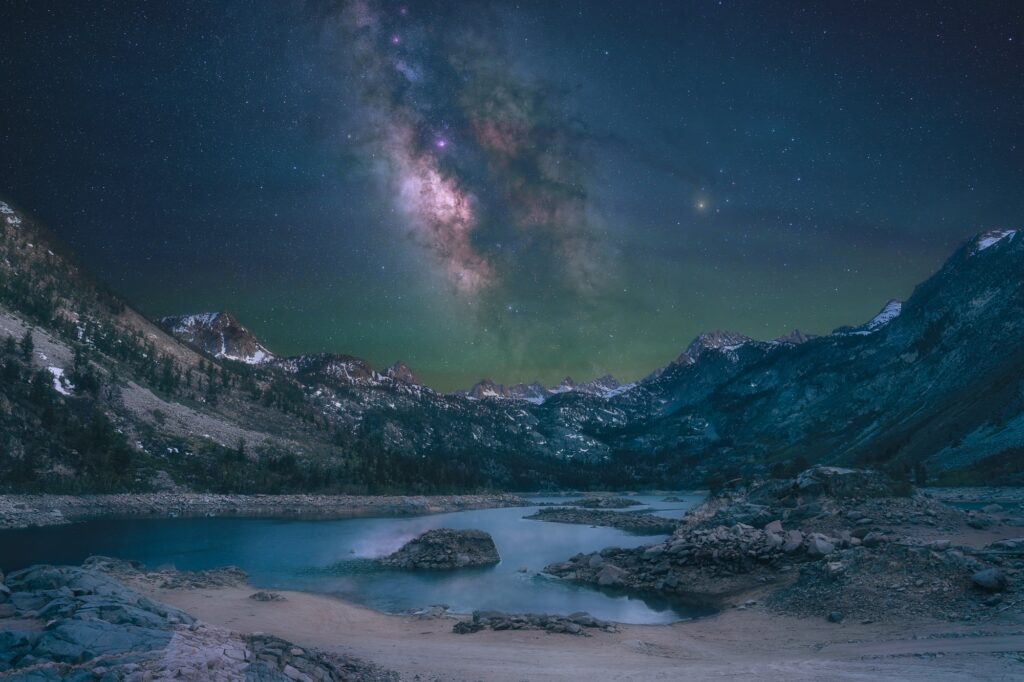If you buy through our links, we may earn an affiliate commission. This supports our mission to get more people active and outside.Learn about Outside Online’s affiliate link policy
Photographer Jay Clue chases dark skies and shares his top tips for shooting the stars and beyond
Waves of green airglow ripple across the night sky above the Sierra Nevada. (Photo: Jay Clue)
Published August 23, 2025 03:00AM
As I stumbled over rocks through pitch darkness, following a guy I had just met online, I began to question my life choices. It was the middle of the night, and I was wandering through a remote desert in Mexico. A thought popped into my mind: this is the setup to a cheesy horror film. But as the night unfolded, the experience changed my life in ways I couldn’t predict.
This scene played out in 2021, when a photo tour operator asked me to scout locations in Baja for night sky photography workshop. At the time, I knew nothing about astrophotography; my life was centered around the ocean. I spent my days working in conservation storytelling, shooting images of marine apex predators and megafauna such as sharks and whales. Ocean photography led me to explore many of the more remote regions of southern Baja looking for new wildlife encounters. It was these remote areas that they were interested in. Not for the marine life, but for the pristine dark skies that can be found there.
I loved showing others the remarkable beauty found along that rocky peninsula I called home. But what I didn’t know was how that crazy evening in the desert would spark my interest in the night sky and send me on this epic side quest to learn how to photograph the stars. There was something so beautifully polar opposite to the underwater wildlife photography I was used to. Time slowed from the rush of capturing shots underwater in mere milliseconds to having an entire evening under the stars in the stillness of the night to create.
It’s been years since that fateful night veered me from the ocean to explore the night sky. Now I structure my weeks around lunar phases, chasing stars during the dark half of the month, and working on other projects during the bright half. What began as pure curiosity has grown into nearly an obsession. It’s changed how I look at photography and has even led me to teach night sky photography classes and workshops around the world
Night sky photography is its own animal and can seem daunting at first, but it’s actually simpler than you might expect. To help you get started, I’m sharing this quick introduction into the art of night sky photography. Ready to rock? Let’s go.
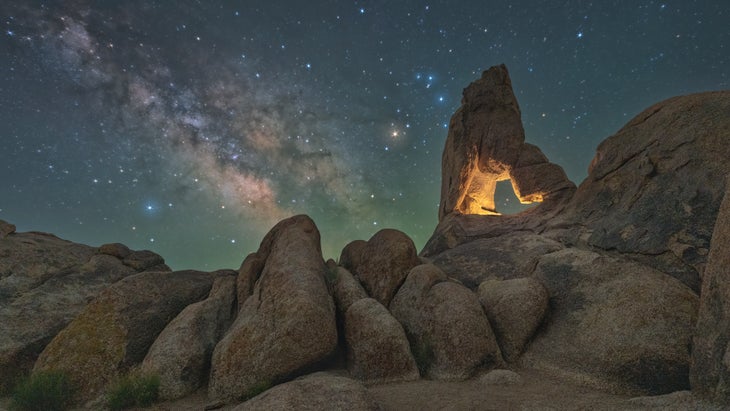
Grab Your Gear and Get Outside
Contrary to popular belief, you don’t need a ton of crazy equipment or fancy gear to shoot the night sky. Grab a sturdy tripod and a headlamp with red light to help your night vision. Pack a wide lens with an aperture of f2.8 or faster for your camera. Then you’re ready to go.
Only have an f4 lens? Don’t stress it; you’ll still be able to get some decent shots until you can upgrade down the road. Like any good outdoor activity, there are, of course, tons of toys you can add on, like a star tracker or an external remote. But they’re not required. They definitely can help to improve your shots, but you don’t need them just to get started.
Finding that Perfect Spot
With our gear prepped, the next step is to find a dark area away from light pollution. Apps like Gaia offer awesome light pollution maps to help you identify the darkest skies nearby. Another excellent option is to check out DarkSky International. This dedicated non-profit works tirelessly worldwide to help preserve and protect our night skies from light pollution. Their website features an interactive map to help locate accredited Dark Sky Places, which are definitely worth exploring.
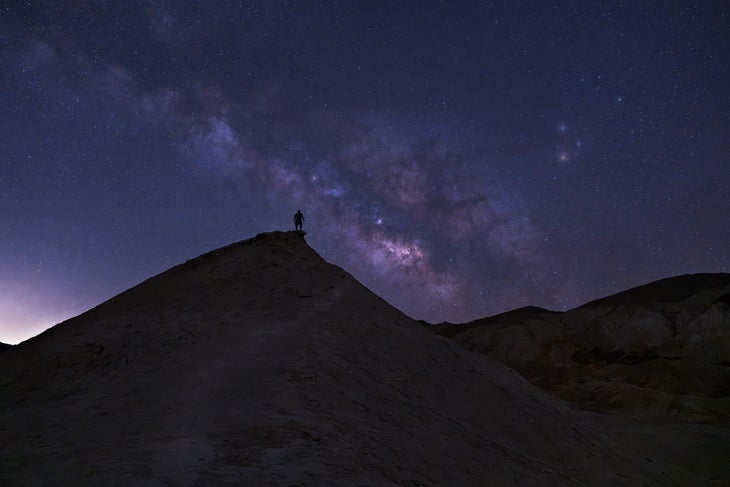
Once you’ve found your zone, the next step is to scout your shots. Trust me, doing this during the day is much easier. I recommend using an app called PhotoPills, which has an augmented reality mode to show the Milky Way’s position in the sky as it moves through the night. This can help you to visualize your composition during the day.
But best of all it allows you to plan shots out days, or even years, in advance. Once I’m happy with my composition, I’ll snap a screenshot of it and drop a pin in Gaia so it’s much easier to locate the exact spot later in the dark. The last thing you want to be doing later is walking around in circles trying to find where that epic shot was.
What About the Moon?
Depending on what you’re looking to shoot, the moon can be your best friend or annoying adversary. The fuller the moon is, or the higher it is in the sky, the brighter the ambient light will be at night. This makes the moon a bit similar to light pollution. In other words, the brighter it is at night, the fewer stars and details we will see in the sky.
For capturing the most stars or a lot of detail in the Milky Way, I’d recommend shooting around the new moon. Or expand this period from the last quarter through the new moon until the first quarter. Make sure to note the moon’s rise and set times, but this will give you a solid couple of weeks to play with. A smaller moon positioned low in the sky can illuminate your foreground, cast shadows, and add depth to your photos, all while allowing you to still capture epic skies.
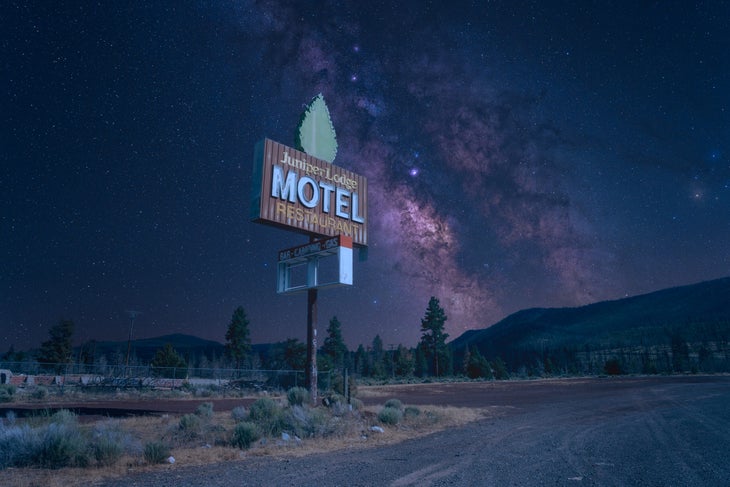
A (Very) Brief Intro to Camera Settings
First, we want to change a few base settings. Always shoot in RAW rather than JPEG to allow greater editing flexibility later. Next, turn off auto noise reduction and switch your camera to manual focus. I also recommend avoiding auto white balance.
Instead, select a different option to ensure consistent white balance across the images. I like using the custom white balance option and setting it to approximately 4300K. This gives a moonlight-esque color balance to the images, but with slightly less blue. Finally, turn on your camera’s self-timer and set it for 2-5 seconds. This brief pause after pressing the shutter helps reduce camera shake in your shots. If you have an external shutter release, a remote, or a smartphone app to control the shutter, that’s even better. Now all that is left is figuring out our exposure.
Exposing images at night is a balancing act. To keep it simple, you’ll want to open up your aperture to gather as much light as possible. Choose a shutter speed slow enough to let in sufficient light, but not so long that stars begin to trail or appear as dashes instead of points. Increase the ISO to a relatively high level, but not so high that we can’t fix the additional noise it adds with photo editing software later. A good starting point for a 20mm or wider lens would be: aperture at f2.8, shutter speed at 13 seconds, and ISO at 3200. Apps like PhotoPills can also help you determine the best shutter speed for your specific camera and lens configuration. Now, let’s move on to the fun part.
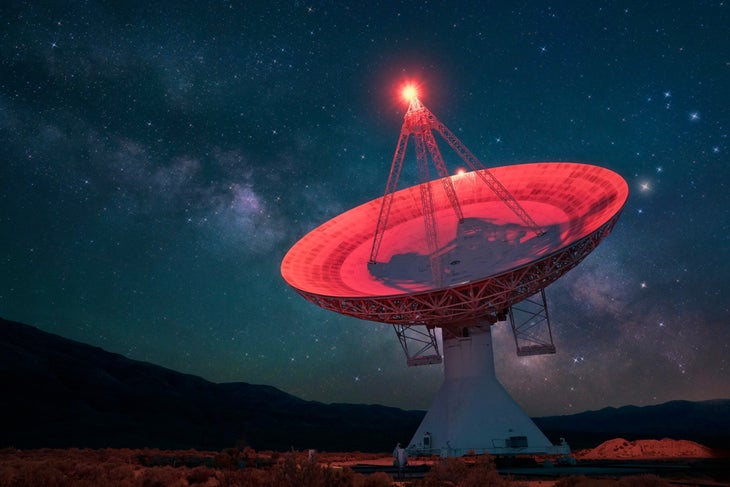
Let’s Take Some Shots
I like to start by first aiming my camera at a bright star and manually focusing on it. Use your camera’s focus magnification to get a close-up of the stars. As you adjust the focus ring back and forth, you’ll notice the stars go from points of light to kind of glowing, blurry disco balls. This isn’t the seventies so we’ll want them to be as close to tiny points of light as possible. Enabling focus peaking in your camera can also make it easier to get them tack sharp.
Once your focus is dialed, set up the tripod with two legs facing you and one aimed at your subject. This gives you some space to work and reduces the chance of bumping into the tripod legs while shooting. Attach the camera to the tripod and begin lining up that beautiful composition you found while scouting earlier in the day. Some cameras, such as those from Sony and Nikon, feature a setting that makes it much easier to compose in the dark. Sony calls theirs Bright Monitoring, Nikon’s is Starlight View. If yours doesn’t have this feature, you can easily use a headlamp to illuminate the foreground while arranging your shot.
Once everything is set, fire off your first test shot and boom! We are rocking. You’ll want to check that your stars are in focus and the exposure looks good. I highly recommend getting to know your camera’s histogram and using it to verify exposure at night. Camera screens can be misleading in low light, but the wise old histogram never lies. From here, it’s tweak, test and repeat. Once you’re happy with your shot, it’s time to get creative and start searching for that next one.
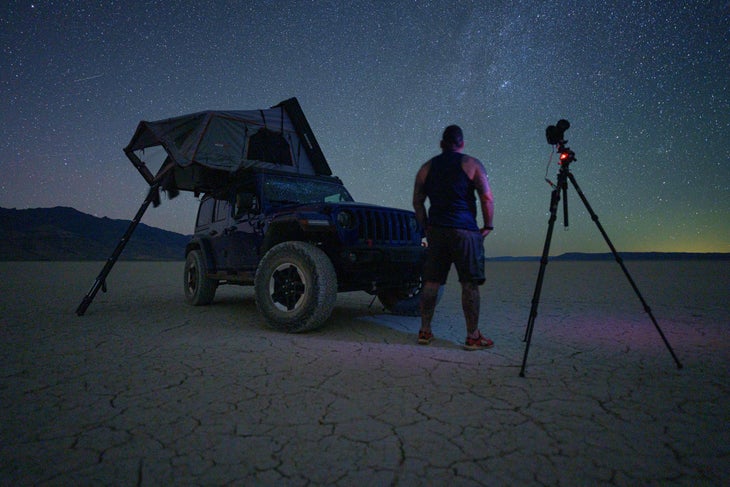
What About Editing?
Due to the challenges of shooting at night, post-processing or editing can play a significant role in night sky photography. We don’t really have space to dive into it for this article. However, there are some great tutorials online, or even better, I’d recommend signing up for a night sky editing workshop to learn it even faster.
The Most Important Tip
I will leave you with one crucial tip. Get outside, have fun, and enjoy every moment. Bring along some snacks or hot cocoa, grab a friend, and explore under the stars.
Astrophotography lets us see a side of the world most people never get to experience. There’s something both magical and humbling about being out in the middle of the night under billions of stars. From witnessing waves of pink air glow wash across the heavens, to curious wildlife encounters, or strange phenomena I can’t quite explain but would make for a fantastic X-Files reboot. The memories I’ve made under the stars are unforgettable.
Plus, even the busiest national parks are empty at night—no crowds or traffic. It’s incredibly beautiful and an experience that will keep drawing you back. So why are you still here? Get out there and start capturing the night.
______________________________________________________________________________
Check out our astrotourism column to find the best stargazing road trips in North America, dark sky retreats, and more.


